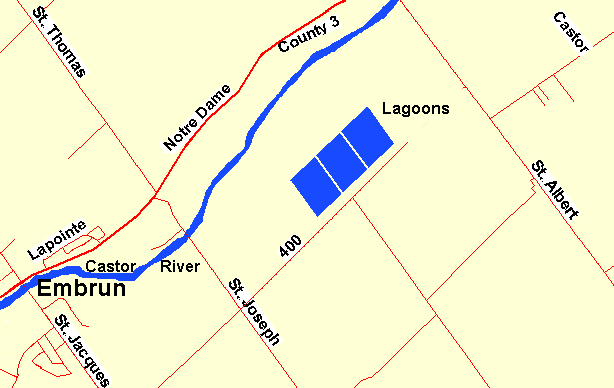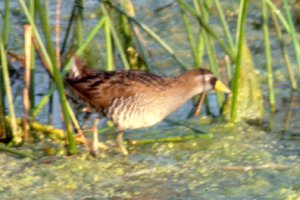EMBRUN SEWAGE LAGOONS
Spring: *** Summer: **** Fall: **** Winter: *
Warning: Sewage lagoons generally do not welcome visitors. Liability insurance is behind much of their reluctance. In the past, they have often made an exception for birders. For some lagoons, the OFNC and/or independent birdwatchers have arranged special access with the operators or wardens. Contact the OFNC to find the current arrangements, if any. Some lagoons are partly visible without crossing the fences, though because of the brem construction, many are not visible from the road. Lagoons are generally not heavily patrolled or impassibly fenced, and when trespassers are unwelcome they are usually just asked to leave; so many birders assume the "No Tresspassing" signs are for someone else (especially given past tolerance). Once in a while, especially in hunting season, hunters make the same assumption. They are less welcome than birders though and are often reported by the locals. After one of these incidents, patrols may be more frequent. The rules seem to change as often as the folks assigned to enforce them; some are more tolerant than others (some are downright helpful). Use courtesy and common sense. And when you park near a sewage lagoon, please don't block the access roads. Even without crossing the fences, a patient and competent birder can see many species as they fly into and out of the lagoons.
Independent Directions to this Site: From Highway 417 (The Queensway), 39 km east of Ottawa, take exit 79 (Regional 5), labelled Limoges / Embrun. Proceed 2.5 km SSE on Regional 5 to Regional 3 or Notre Dame Street. Turn right or WSW onto it and drive 2.8 km to St.-Joseph Road on the east edge of the town of Embrun. Turn left or SSE on it and go 1.5 km to Route 400. Turn left or northeast onto Route 400 and after about a kilometre the Embrun Sewage Lagoons will be on your left.
Eastern Sewage Lagoons Route Route Directions: From the Dignard Constructed Wetland return WSW to County Road 28 or St-Guillaume Road and turn left or SSE on it. Drive 3.7 km to Castor Street or CR 3. Turn left or ENE on Castor and proceed 4.2 km through Embrun (where CR 3 becomes Notre Dame Street) to St. Joseph Road. Turn right or SSE onto it and go 1.5 km to Route 400. Turn left or northeast onto Route 400 and after about a kilometre the Embrun Sewage Lagoons will be on your left.
 Map of Embrun Sewage Lagoons area
Map of Embrun Sewage Lagoons area
Site Description and Birding Information: This is one of the best sewage lagoon sites in our area, if not the best. Birders are generally tolerated here, but contruction was undertaken in 2002, and visitors were not welcome when work was ongoing. So check for work activity and avoid it if that is under way; the birds probably do too. Park along the road near one of the access gates and walk around the dykes circling the ponds. Usually one of the three ponds is full and at least one fairly low. This gives a great variety of habitat that varies, not only from year to year, but often from month to month. Be sure to keep the sun at your back as much as possible to prevent glare.
All the regular species of shorebirds which pass through the Ottawa area have been seen here, Semipalmated (mid-May to early June and mid-July to mid-Oct.), Least (May and July through early Oct.) Sandpiper. Less common species such as White-rumped (late May and Aug. through early Nov. - peaking in Oct.) and Stilt (mid-Jul. through Sep.) Sandpiper are regular here. Uncommon species are sometimes seen, including Baird's, and Buff-breasted Sandpipers, Red-necked Phalarope (late May and Aug. through Sep.), Red Knot, Hudsonian Godwit (Sep-Oct), Whimbrel and Long-billed Dowithcher (mid-Sep. to mid-Oct.). Keep a eye out for flight activity by the shorebird flocks, indicating that they may have spotted a threat. These threats may be a avian predator, such as a Peregrine Falcon or Bald Eagle, both having been seen here. Watch also for migrating swallows, waterfowl and gulls. Redhead (May and June), Surf and White-winged Scoter (October) are among the less common waterfowl to have been seen here. Tundra Swan has been seen here in spring, most recently in 2005. The surrounding area may host a number of raptors, including Northern Harrier and Red-tailed and Rough-legged Hawks. Breeding birds include Ruddy Duck, Sora, Virginia Rail and Wilson's Phalarope.
Rarities found here include Marbled Godwit (May 31-Jun. 8, 1988), Sharp-tailed Sparrow (Sep. 1988), Willet (Jun. 5, 1989; May 21, 2000; May 29, 2009), Eared Grebe (Aug. 12 to Sep. 17, 1990; Jul. 1 to 21, 2011), Yellow-headed Blackbird (Sep. 1, 1990), Ruff (Jul. 3-5, 1988; May 29, 1991; May 10-11, 2003; May 2-3, 2004), Scissor-tailed Flaycatcher (Jul. 25, 2001), Tundra Swan (Apr. 16 - 29, 2005), Trumpeter Swan (May 4-25, 2009).
 Sora at Embrun Sewage Lagoons
Sora at Embrun Sewage Lagoons
Eastern Sewage Lagoons Route Route Directions: From the Embrun Sewage Lagoons return via Route 400 to St.-Joseph Road and turn right or northeast on it. Proceed 1.5 km to Notre Dame Street or Regional 3. Turn right or ENE on Regional 3 and drive 2.8 km to Regional 5. Turn right or SSE onto it and go 6.6 km to the 90 degree left turn to the ENE toward St. Albert. Continue on Regional 5 another 2.2 km to the Crysler turnoff, where Regional 5 turns SSE. Continue ENE on Regional 7 watching for the sign for the sewage lagoons, on the south, opposite house number 1664. This is the next site on this loop, the St. Albert Sewage Lagoons.
Return to Eastern Sewage Lagoons Route.
Return to Birding Ottawa Table of Contents.
|

